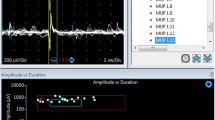Abstract
Purpose
To evaluate the usefulness of somatosensory evoked potential as a screening tool for spinal pathologies in patients with treatment refractory overactive bladder.
Methods
This prospective study was performed between January 2011 and January 2014. Children >5 years old with treatment refractory overactive bladder were enrolled after exclusion of anatomical and neurological causes of incontinence. All patients underwent urodynamic studies, spinal MRI, and somatosensory evoked potential (SEP). Sensitivity, specificity, PPV, and NPV were calculated for SEP.
Results
Thirty-one children (average age 8.3 ± 2.9 years) were included in the study. SEP was abnormal in 13 (41.9%), and MRI was abnormal in 8 (25.8%) patients. SEP was found to have a sensitivity of 87.5%, a specificity of 73.9%, positive predictive value of 53.85%, and negative predictive value (NPV) of 94.4%.
Conclusion
In patients with treatment refractory OAB, SEP is an important tool for the screening of tethered cord/spinal pathologies. Our results suggest that a child with a normal SEP study in this group of patients may not require further investigation with MRI.


Similar content being viewed by others
References
Ayan S, Topsakal K, Gokce G, Gultekin EY (2007) Efficacy of combined anticholinergic treatment and behavioral modification as a first line treatment for nonneurogenic and nonanatomical voiding dysfunction in children: a randomized controlled trial. J Urol 177:2325–2328 discussion 2328–9
Chase J, Austin P, Hoebeke P, McKenna P (2010) The management of dysfunctional voiding in children: a report from the Standardisation Committee of the International Children’s Continence Society. J Urol 183:1296–1302
Hoebeke P, Renson C, Petillon L et al (2002) Percutaneous electrical nerve stimulation in children with therapy resistant nonneuropathic bladder sphincter dysfunction: a pilot study. J Urol 168:2605–2607 discussion 2607–8
Maternik M, Krzeminska K, Zurowska A (2014) The management of childhood urinary incontinence. Pediatr Nephrol. doi:10.1007/s00467-014-2791-x
Malm-Buatsi E, Nepple KG, Boyt MA et al (2007) Efficacy of transcutaneous electrical nerve stimulation in children with overactive bladder refractory to pharmacotherapy. Urology 70:980–983
Khen-Dunlop N, Van Egroo A, Bouteiller C et al (2006) Biofeedback therapy in the treatment of bladder overactivity, vesico-ureteral reflux and urinary tract infection. J Pediatr Urol 2:424–429
Lordêlo P, Benevides I, Kerner EG et al (2010) Treatment of non-monosymptomatic nocturnal enuresis by transcutaneous parasacral electrical nerve stimulation. J Pediatr Urol 6:486–489
Varlam DE, Dippell J (1995) Non-neurogenic bladder and chronic renal insufficiency in childhood. Pediatr Nephrol 9:1–5
Yamada S, Iacono RP, Andrade T et al (1995) Pathophysiology of tethered cord syndrome. Neurosurg Clin N Am 6:311–323
Steinbok P, MacNeily AE (2007) Section of the terminal filum for occult tethered cord syndrome: toward a scientific answer. Neurosurg Focus 23:E5
Khoury AE, Hendrick EB, McLorie GA et al (1990) Occult spinal dysraphism: clinical and urodynamic outcome after division of the filum terminale. J Urol 144:426–428 discussion 428–9, 443–4
Nazar GB, Casale AJ, Roberts JG, Linden RD (1995) Occult filum terminale syndrome. Pediatr Neurosurg 23:228–235
Kraft GH, Aminoff MJ, Baran EM et al (1998) Somatosensory evoked potentials: clinical uses. Muscle Nerve 21:252–258
Kiliçkesmez O, Barut Y, Taşdemiroğlu E (2003) MRI features of adult tethered cord syndrome. Tani Girisim Radyol 9:295–301
McLone DG, La Marca F (1997) The tethered spinal cord: diagnosis, significance, and management. Semin Pediatr Neurol 4:192–208
Kale SS, Mahapatra AK (1998) The role of somatosensory evoked potentials in spinal dysraphism—do they have a prognostic significance? Childs Nerv Syst 14:328–331
Li V, Albright AL, Sclabassi R, Pang D (1996) The role of somatosensory evoked potentials in the evaluation of spinal cord retethering. Pediatr Neurosurg 24:126–133
Ko KF (2010) The role of evoked potential and MR imaging in assessing multiple sclerosis: a comparative study. Singap Med J 51:716–720
Haghighi SS, Mundis G, Zhang R, Ramirez B (2011) Correlation between transcranial motor and somatosensory-evoked potential findings in cervical myelopathy or radiculopathy during cervical spine surgery. Neurol Res 33:893–898
Author information
Authors and Affiliations
Corresponding author
Ethics declarations
Conflict of interest
Authors have no conflict of interest to declare.
Rights and permissions
About this article
Cite this article
Thomas, D.T., Yener, S., Kalyoncu, A. et al. Somatosensory evoked potentials as a screening tool for diagnosis of spinal pathologies in children with treatment refractory overactive bladder. Childs Nerv Syst 33, 1327–1333 (2017). https://doi.org/10.1007/s00381-017-3393-2
Received:
Accepted:
Published:
Issue Date:
DOI: https://doi.org/10.1007/s00381-017-3393-2




